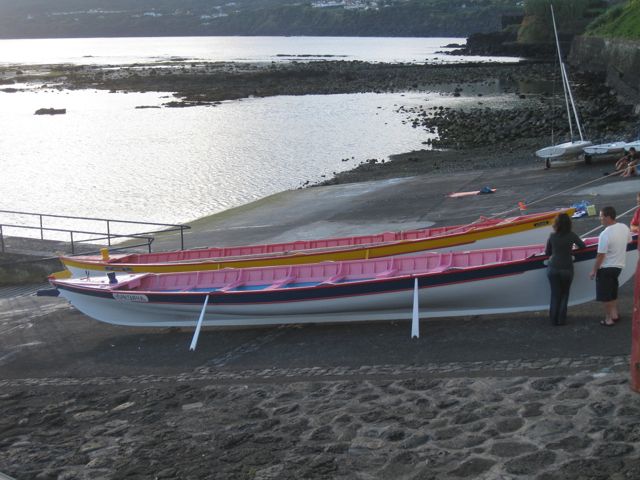(click on photos to enlarge them)
It was a beautiful day for a walk from Aldeia da Fonte, the inn where I was staying, to the nearby town of Lajes do Pico, about 2 kilometers away.
 |
| These stone wall vineyards and gardens are seen all over the island of Pico. They absorb and radiate heat, which helps to keep the plants warm and protected from the cool ocean breezes. |
 |
| Rustic ruins abound... |
 |
| An império for the Espirito Santo. |
 |
| The local beekeepers association and school for beekeeping. |
 | |||||
| The old and the new co-exist side by side. |
 |
| Little farms are everywhere. |
 |
| Walled fields being used for farming and rotational grazing. |
Just to show it isn't all rustic and quaint...
 |
| There is a public housing project on the edge of town... |
 |
| ...and quite a few modern suburban-style homes, probably owned by "Americanos" – emigrants who have returned... |
 |
| ...and an equally unappealing shopping center. |
 |
| Another império... |
 |
| ...and the Espirito Santo gear inside – no anthropomorphic images, just a crown and a picture of a dove. |
 |
| An old fort turned into a museum (closed the day I was there). |
 |
| Not a bad place to lay your burden down. |
 |
| Even in town, everyone has a little vegetable garden tucked away in their yard. |
 |
| Grapevines are often used to make a car port or shaded areas on small streets and passageways. |
 |
| As in Horta on Faial, there is still the great use of color... |
...and the Portuguese paving, though not nearly as much of it.



This decorated alley was a clue that something interesting was in the works.


This basket of beautiful bread was also a clue...

...as was this saintly little guy...

...who led me to this small chapel with many people filing in and out as hymns were sung.

Then the band showed up...

...and the Queen and her posse...



...and then the procession began (the guy leaning against the wall on the right in the first picture leads the way, shooting off skyrockets).





...ending up at the band's rehearsal building for a lunch of special Holy Spirit soup.


The saints approve.

But wait! There's more!

People were still lining the street and hanging out in front of the main church, where more of that bread was being stashed. I found out later that these are called rosquilhas, a kind of large donut- or bagel-shaped (or, according to my own personal theory, halo-shaped) sweet bread loaf made only during certain festas, usually associated with the Festa do Espirito Santo — not to be confused with the biscotti-like rosquillas found in Spain and parts of Latin America.






Soon there was another procession coming from the church, this time with two statues of São Pedro - the first one was being carried by women, the second one by men who were accompanied by a couple of priests.





Eventually the procession came back towards the church, led (as always) by the pyrotechnician, the saint's standard-bearer, and the queen's posse...



...but this time including ladies with huge baskets of rosquilhas on their heads!




By now the plaza was getting seriously filled with bread, lined up to be blessed by the priest; I think I counted nearly 100 baskets.




Then there was a concert with two bands, including the one from the procession and another one. They played what I assume were traditional Azorean tunes and religious hymns, but eventually broke into "Stand by Me" and Harry Nilsson's "Without You". Notice the building completely covered in vines in the second picture.



After the festa they loaded up the rosquilhas in trucks and drove all around town handing them out for free to anyone who wanted them. (Sorry, no pics of that.) This tradition comes from a legend concerning Queen St. Isabel, who used to feed the poor against the king's wishes. Once she was out giving bread to the poor when the king saw her and demanded she show him what was inside her apron. When she opened it, the bread had been miraculously turned into roses.
 |
| Old-style whaling boats called canoas, now used for sport. |
 |
| Not a bad ending to the day! |